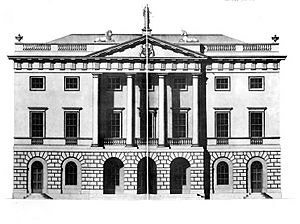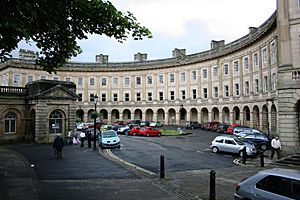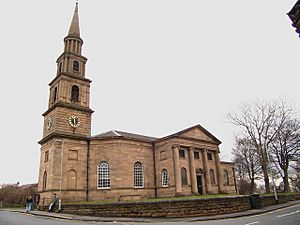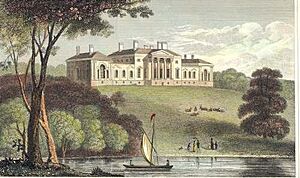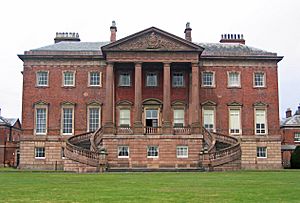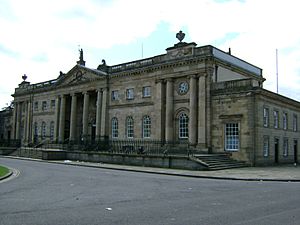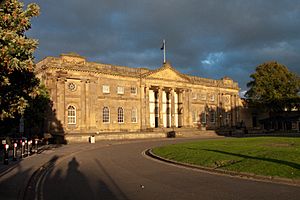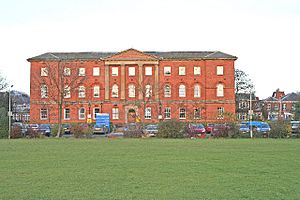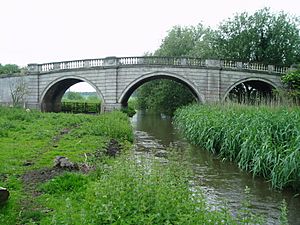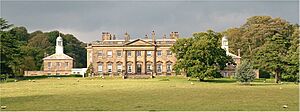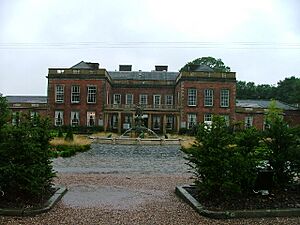John Carr (architect) facts for kids
Quick facts for kids
John Carr
|
|
|---|---|
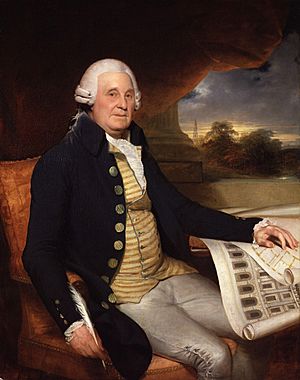
Portrait of John Carr by William Beechey, 1791
|
|
| Born | 1723 Horbury, West Riding of Yorkshire
|
| Died | 22 February 1807 (aged 83–84) Askham Richard
|
| Nationality | English |
| Occupation | Architect |
| Buildings | Harewood House, Buxton Crescent, Constable Burton Hall, Tabley House, Basildon Park, Lytham Hall, Fairfax House |
John Carr (1723–1807) was a very busy and important English architect. He is best known for designing Buxton Crescent in Derbyshire and Harewood House in West Yorkshire. Much of his work was in the Palladian style, which means it followed the ideas of a famous Italian architect named Andrea Palladio. In his time, many people thought he was the best architect in the north of England.
Contents
Life of a Master Builder
John Carr was born in Horbury, a town near Wakefield, England, in 1723. He was the oldest of nine children. His father was a master stonemason, someone who works with stone, and John learned his skills from him.
He started his own career in 1748 and worked almost until he died. John Carr was even the Lord Mayor of York twice, in 1770 and 1785. Later in his life, he bought a large property in Askham Richard, near York, where he retired. He passed away there on February 22, 1807. He was buried in St Peter and St Leonard's Church, Horbury, a church he had designed and paid for himself.
Carr's Amazing Career
Carr decided to stay in Yorkshire instead of moving to London. He believed there were enough wealthy people and projects in the north to keep him busy. No job was too small for him. His biggest project, though not fully finished, was the Hospital de Santo António in Oporto, Portugal.
To earn as much as possible, he kept his team small. He traveled huge distances, mostly on horseback, to visit his many clients. This frequent contact helped him build strong relationships.

Famous Buildings and Public Works
John Carr's favorite design was the Crescent at Buxton in Derbyshire. This building was special because it had many uses all under one roof. It included hotels, lodging houses, Assembly Rooms, shops, a post office, and a public walkway. His Newark Town Hall was also designed in a similar way, combining different functions.
He also designed other public buildings. These included hospitals in places like Lincoln and York. He designed grandstands for racecourses in York, Doncaster, and Nottingham, though these are now gone. He also designed prisons in Wakefield and Northallerton.
Carr designed new churches and repaired old ones. The new churches he built were paid for by private individuals. He used a special roof design that allowed him to build churches without the usual separate sections for the nave and aisles.
Master of Bridges
Carr was also in charge of bridges for both the North and West Ridings of Yorkshire. He left behind many bridges, and most of them are still standing today. More than 60 bridges he built or changed are still used as important parts of North Yorkshire's road network.
Country Houses and Estates
John Carr designed many grand country houses. These projects often included entire estates with model villages, farms, stable buildings, gatehouses, and even garden temples. Some of his most famous works were for the large estates of Harewood and Wentworth Woodhouse.
He was very careful with his plans and construction. He wanted to make sure his buildings were good value for money and would last a long time. He used traditional materials and methods that had proven to be strong. But he also used new ideas if they were better. Because he trained as a stonemason, he loved building with stone, especially large stones, like at Tabley House.
Carr liked rooms that were well-proportioned and comfortable to live in. He believed fancy decorations could be added later if there was enough money. Because of his careful work, most of his buildings were completed and still stand today.
Places You Can Visit Today
Many of John Carr's buildings are open to the public. You can visit places like Buxton Crescent, Newark Town Hall, and almost all of his bridges. Other examples include Harewood House, Tabley House, Clifton House (a museum in Rotherham), Lytham Hall, and Fairfax House in York.
Carr's Design Style
During his long career, architectural styles changed a lot. John Carr's early work mixed the Palladian style with the Rococo style. Later, he looked for a purer Ancient Roman style, sometimes with French influences. He then adapted to the popular style of Robert Adam. Towards the end of his life, he went back to the bolder Palladian style he started with, but with details that looked forward to the 19th century.
Carr was influenced by the books of famous architects like Sebastiano Serlio and Andrea Palladio. He also used many architectural pattern books, including those by his friend George Richardson, and other books by Robert Morris and William Chambers.
Some of John Carr's Works
John Carr designed many buildings throughout his career. Here are a few examples from different categories:
Public Buildings
- Oporto, Portugal: The Hospital de Santo António (started 1769)
- Newark Town Hall, Nottinghamshire: Town Hall, Assembly Rooms, and Market Hall (1773–76)
- York: Assize Courts, now York Crown Court (1773–77)
- York County Lunatic Asylum (1774–77)
- Lincoln County Hospital, Lincolnshire (1776)
- Buxton, Derbyshire: The Assembly Rooms in the Crescent (1779–90)
- York: The Female Prison (1780–83)
Churches
- Ravenfield (1756)
- Dewsbury Minster: Partly rebuilt (1765–67)
- Holy Rood Church, Ossington, Nottinghamshire (1782–83)
- St Peter and St Leonard's Church, Horbury (1790–94)
Bridges
John Carr designed or improved over 60 bridges, mostly in Yorkshire. Here are a few examples:
- Aysgarth (River Ure) (1788)
- Bainbridge (Yore Bridge, 1793, and Bain Bridge, widened 1785)
- Catterick (River Swale) (1792)
- Croft (River Tees) (1795)
- Ferrybridge (River Aire) (1797–1804)
- Richmond (River Swale) (1789)
Domestic Architecture (Houses and Estates)
John Carr designed or altered many grand homes and their surrounding buildings.
- Fairfax House, York (around 1755–62)
- Lytham Hall, Lancashire (1757–64)
- Harewood House (1755–71)
- Tabley House, Cheshire (around 1760–67)
- Wentworth Woodhouse (completed the house and many estate buildings, around 1760–1804)
- Aske Hall (around 1765–69)
- Denton Hall, Wharfedale (1769–81)
- Basildon Park, Berkshire (1776)
- Colwick Hall, Nottinghamshire (remodelled 1776)
- The Crescent and Great Stables in Buxton, Derbyshire (1779–90)
See also
 In Spanish: John Carr para niños
In Spanish: John Carr para niños


